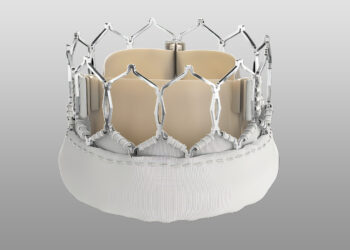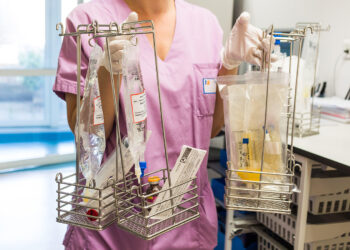[ad_1]
With the introduction of percutaneous options, the role of surgery in the repair of dysfunctional tricuspid valves is being reevaluated in an effort to reduce the risk for end-stage disease.
In the midst of transformative transcatheter approaches to repair diseased aortic and mitral valves, the tricuspid valve has been overshadowed, according to Michael E. Bowdish, MD, vice chair of the Department of Cardiac Surgery at the Smidt Heart Institute at Cedars-Sinai in Los Angeles, who says he foresees a change.
“There has been a long-standing belief that the tricuspid valve does not matter so much, and this was largely premised on the data suggesting that tricuspid surgery is associated with high operative risk,” he explained during a symposium devoted to tricuspid valve repair at the Society of Thoracic Surgeons (STS) Annual Meeting in Los Angeles.
With tricuspid repair surgery, “in-hospital mortality rates have been reported historically to be about 10%-15%, but recent studies show that contemporary rates are 5%-7%, or about half of what has been reported in the past,” said Bowdish, citing recently published data from the STS Adult Cardiac Surgery Database.
Surgical Deaths Cut in About Half
In cases of severe tricuspid regurgitation, which has a 1-year mortality rate approaching 40% if left untreated, surgery is often not considered. Although the first surgical intervention for tricuspid regurgitation was performed almost 60 years ago, isolated regurgitation procedures have been relatively uncommon because of the high in-hospital mortality rates once reported.
Surgical repair or valve replacement for severe tricuspid regurgitation has been most often performed during the concomitant repair of diseased aortic or mitral valves, according to a recently published overview. But outcomes of isolated procedures in the STS database suggest a reasonable benefit-to-risk ratio for operative risk and good durability after the acute postoperative period.
The relatively new percutaneous trial data have been instrumental to drawing attention to more aggressive therapies for tricuspid regurgitation overall, which includes surgery.
In the TRILUMINATE trial, the primary endpoint — a hierarchical composite that included death, hospitalization for heart failure, and quality of life — was better at 30 days with the TriClip G4 device (Abbott), a transcatheter edge-to-edge repair system, than with medical therapy (win ratio, 1.48; P =.02).
In the subsequent TRISCEND II trial, the primary endpoint — a hierarchical composite that included death, right ventricular assist device implantation, hospitalization for heart failure, and quality of life — was better at 1 year with the EVOQUE (Edwards Lifesciences) transcatheter tricuspid valve replacement system than with medical therapy (win ratio, 2.02; P <.001 wp_automatic_readability="81.230769230769">
Results from the recently published European Tri.Fr trial of transcatheter repair were comparable to those of TRILUMINATE. Several other tricuspid valve repair devices and replacement valves are now in clinical trials. Both the transcatheter repair and tricuspid valve replacement devices evaluated in the TRILUMINATE and TRISCEND II trials, respectively, were approved in 2024.
Is Surgery More Durable?
With new evidence that surgery has an acceptable risk, particularly in patients with severe tricuspid regurgitation, who have a poor prognosis, the two approaches will likely be “complementary,” Bowdish explained. However, he acknowledged, more data are needed to understand which approach will provide the greatest improvement in quality of life and long-term survival in specific patient populations.
So far, follow-up after transcatheter procedures is limited, so it is too early to judge whether one should be considered over the other in patients with a long life expectancy.
This is an important question that deserves to be addressed as the data mature, said Rebecca T. Hahn, MD, director of interventional echocardiography at the Columbia Structural Heart and Valve Center, Columbia University, New York City. She pointed out that results from the TRISCEND II trial, for which she was principal investigator, showed a benefit in an older population with multiple comorbidities. Enrollment in that trial was limited people in whom optimal medical therapy had failed.
Such patients “are seeking a therapy that will improve their quality of life, which has been clearly shown with transcatheter repair and replacement therapies,” Hahn said.
For those with a long-life expectancy, evidence of the durability of tricuspid valve repair “will be required to make management decisions,” such as whether to perform a transcatheter procedure or surgery, she added.
A risk model for isolated tricuspid valve operations was created from the recently published STS tricuspid repair data. It showed that operative mortality is similar for repairs and replacements and also provided a benchmark from which to predict risk associated with invasive procedures in specific patient groups, such as those with endocarditis. This is one step toward a data-driven approach for comparing interventions.
Data Comparing Procedures Needed
Risks for structural heart disease and noncardiac complications are markedly different with tricuspid valves vs aortic and mitral valves. For example, severe tricuspid regurgitation causes and exacerbates right-sided heart disease while producing ascites and driving liver failure. Although Bowdish characterized the emerging and evolving options for severe tricuspid regurgitation as “exciting,” he cautioned against drawing conclusions about the relative roles of surgery and transcatheter approaches “ahead of the data.”
A follow-up period of 3-5 years — optimally from a randomized trial — is needed to understand the relative durability of percutaneous and surgical repairs of the tricuspid valve, he suggested. To determine the effect on prognosis for periods extending beyond 5 years, even longer follow-ups are needed, as are studies designed to determine whether earlier repair prevents major regurgitation complications and improves survival.
In an era of expanded therapy options, the impaired tricuspid valve is “no longer forgotten,” according to the title assigned to the STS symposium. Both surgeons and interventionalists have a role to play in moving this field forward, Bowdish added.
Bowdish reports financial relationships with Renibus Therapeutics. Hahn reports financial relationships with Abbott Vascular, Baylis Medical, Edwards Lifesciences, Medtronic, and Philips.
[ad_2]
Source link : https://www.medscape.com/viewarticle/rethinking-timing-tricuspid-valve-repairs-2025a10003k2?src=rss
Author :
Publish date : 2025-02-11 14:40:16
Copyright for syndicated content belongs to the linked Source.














